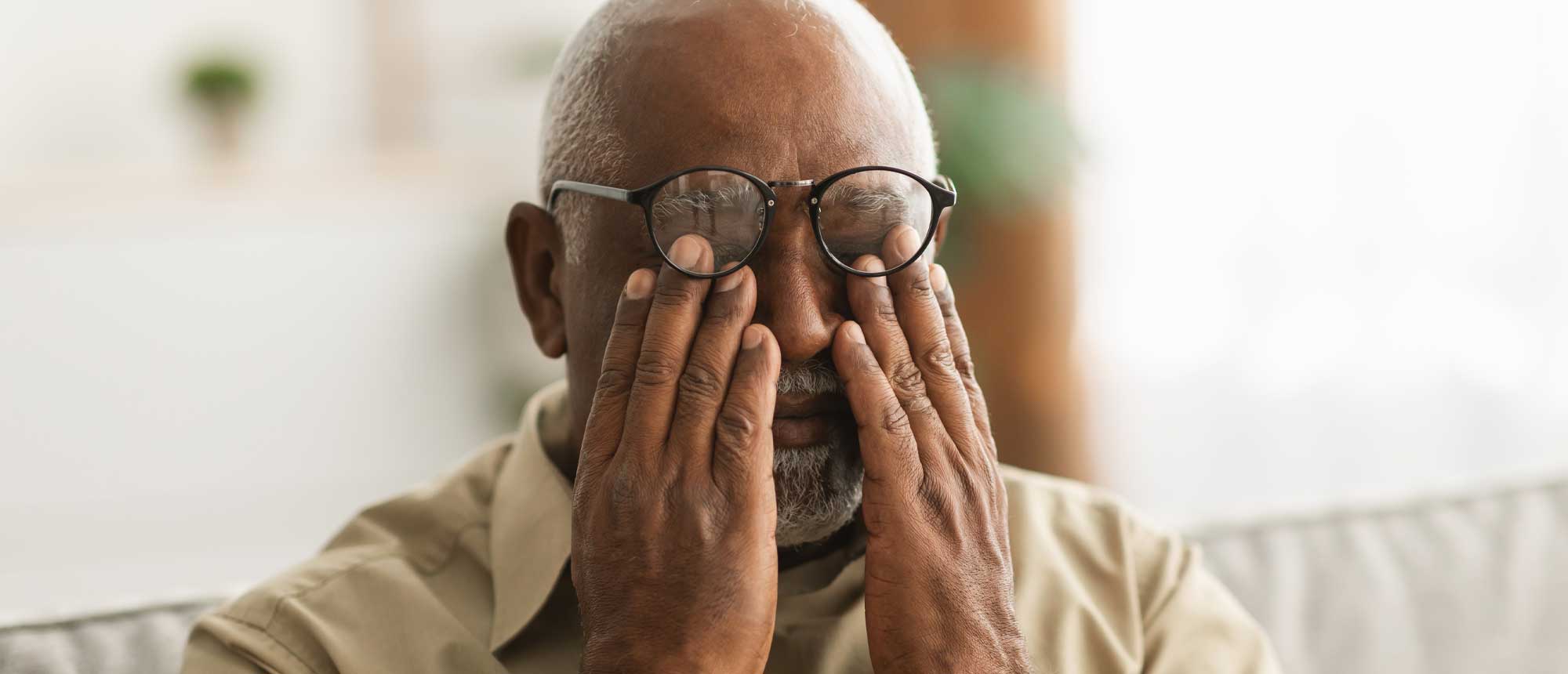01 Mar Glaucoma in Seniors: Symptoms & Care
By Jeannette Franks, PhD
Glaucoma is a cluster of diseases that can damage the eye’s optic nerve and result in irreversible vision loss-and ultimately can cause total blindness. It is one of the leading causes of legal blindness in the US and probably the most preventable cause of vision loss. Glaucoma tends to run in families and most often occurs in people over the age of 60. As baby boomers age, we can anticipate more and more cases of glaucoma in seniors.
Anyone can get glaucoma, but for reasons that are not fully understood, it is more common in people of African-American and Mexican-American ancestry. In addition to family history, other risk factors include nearsightedness (myopia), previous eye injury, low blood pressure, diabetes and long exposure to cortisone, a steroid hormone.
Our eyes contain fluid which maintains a constant pressure within the eyeball. When the valve that regulates this liquid, and thus the pressure, malfunctions, the optic nerve becomes damaged by the increased pressure in the eye. This process is painless and gradual, and vision usually seems normal as it’s happening.
COMMON TYPES OF GLAUCOMA IN SENIORS
There are several types of glaucoma:
- Isopen-angle Glaucoma: The most common type of glaucoma, this results in a slow, painless loss of peripheral vision. Approximately 1% of all Americans have this type.
- Withopen-angle Glaucoma: With this type, one’s field of vision slowly, imperceptibly narrows as peripheral vision deteriorates. Vision damaged this way is often compared to looking through a tunnel, but it is actually more akin to looking at the world through a paper towel tube.
- Low-tensionornormal Tension Glaucoma: This type is more challenging to detect because the intraocular pressure is within normal parameters. It is thought to be related to impaired blood flow to the optic nerve.
- Fromangle-closure Glaucoma: If intraocular pressure becomes too high, the iris is forced against part of the eye and blocks drainage. When the drainage becomes completely blocked, it will result in an acute glaucoma attack, which can lead to vision loss very quickly.
RARE TYPES OF GLAUCOMA
There are also several rare types of glaucoma that can affect seniors:
- Pigmentary Glaucoma: This most often affects nearsighted people and men more than women. It might begin even in the early twenties or thirties and is particularly threatening to vision over a lifetime.
- Trauma-related Glaucoma: This can be cause by any serious blow to the eye, chemical burn, or penetrating injury.
DETECTING GLAUCOMA IN SENIORS
Only a full vision exam, including tonometry, a visual field exam, visual acuity assessment and a dilated eye exam can determine if one has any of these types of glaucoma. Tonometry measures the ocular pressure by determining the resistance of your cornea to indentation, usually by directing a quick, painless puff of air at the eye. A visual field exam tests the full field of vision by asking if you can see a series of objects or flashes of light in various locations, for example on a computer screen. The visual acuity exam starts with the familiar eye chart with the tumbling E’s.
The dilated eye exam is where drops are put in the eyes to dilate (widen) the pupils so that the physician can examine the retina and optic nerve. The drops may cause blurring of vision for several hours, although most people are still able to drive afterwards.
The American Academy of Ophthalmology recommends a full eye exam for everyone under 40 every five to ten years; after the age of 40 every two to four years, and annually after the age of 55. Full exams are recommended annually for those over 50 with a family history of glaucoma.
GLAUCOMA PREVENTION
It is unclear what can prevent glaucoma in seniors. However, a 2007 study in the journal of the American Academy of Ophthalmology found a decrease of intraocular pressure (IOP) in rats on a diet enriched in omega-3 fatty acids and an increase in IOP in rats fed an omega-3 fatty acid deficient diet. Researchers had noted that traditional Western diets are low in omega-3 fatty acids while omega-3 fatty acids are quite high in the fish-rich Japanese diet. IOP increases with age in Western populations, while it actually decreases with age in Japan. Studies on humans at the present time are limited. Wild salmon, tuna, herring, mackerel, anchovies, and sardines are good natural sources of omega-3 fatty acids. Fish oil supplements are also high in omega-3 fatty acids.
The single most important thing one can do to prevent vision loss from glaucoma is to have regularly scheduled full eye exams.
GLAUCOMA TREATMENT
There is no cure for glaucoma. All types of glaucoma are controlled with medications (usually eye drops, but can be oral as well) and surgery. Several of the more commonly prescribed medications include:
- Alpha-adrenergic agonists
- Beta blockers
- Carbonic anhydrase inhibitors
It is essential that the medication be taken exactly as prescribed and that the annual exam includes a medication review. Some drugs stop working over time or may have negative interactions with other prescriptions. Only a physician can appropriately monitor glaucoma and glaucoma medications.
Often an older person will need help with eye drops because of a tremor or fine motor control issues. Special devices can help make the application of drops easier. Check out the Community Services for the Blind catalogue with the “eye drop guide” (http://www.sightconnection.com/).
Memory problems increase the risk of missing medications dramatically. Remember, vision lost from glaucoma is lost forever; it is irreversible. A family member or trained aide must assist a memory-impaired person with glaucoma medicationevery day.
Based on recent reviews by the National Eye Institute and the Institute of Medicine, a task force on complimentary therapies found no scientific evidence that proved increased benefits of marijuana use to treat glaucoma compared to the wide variety of prescription medications available. While marijuana does indeed lower intraocular pressure, a person would need to smoke a marijuana cigarette eight to ten times a day. Medical marijuana is still illegal in most of the US.
Laser surgery is another treatment option for glaucoma in seniors. Using a laser, part of the anterior chamber is changed to make it easier for the fluid to exit the eye. Usually the patient will also continue to take glaucoma medications and monitor intraocular pressure with an annual exam.
LOW VISION REHABILITATION
Because vision lost to glaucoma cannot be restored, it is imperative for people with glaucoma-related vision loss to understand and utilize low vision rehabilitation. New training and technology can help make the most of remaining vision. Many community organizations and agencies offer information about low vision counseling, vision and technology training, support groups, and other special services for people with visual impairments. An excellent initial contact to find low vision rehabilitation in your area is the national senior information helpline: 1-800-766-1116 or https://eldercare.acl.gov/Public/Index.aspx
A physician may say to someone with glaucoma who has experienced permanent vision loss, “You’re legally blind, and there’s nothing I can do.” This is devastating news to anyone, and the person hears, “there’s nothing I can do” and thinks that there’s nothing more to be done. However, what the doctor should say is, “there’s no way I can restore your lost sight, but experts in low vision can help you make the most of the vision you still have.”
Legally blind is specifically defined as 20/200 in the best eye with the best corrective lenses. For example, with my lovely new bifocals, I have 20/20 vision. A sign that I can read 200 feet away, a legally blind person with 20/200 vision would need to walk up to the sign until 20 feet away to be able to read it with his or her best glasses. Most people who are thought of as blind have some functional vision.
For people with total blindness, mobility training, instruction in activities of daily living, and social services are also widely available.
For more information on glaucoma in seniors, contact the Glaucoma Foundation at http://www.glaucomafoundation.org/index.php
Jeannette Franks, PhD, is a passionate gerontologist who teaches at University of Washington and Bastyr University; she is the author of a book on assisted living and numerous articles.
Source: <http://www.aplaceformom.com/senior-care-resources/articles/glaucoma-in-seniors>


